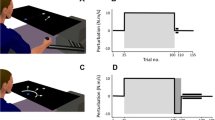Abstract
It has long been supposed that the interference observed in certain patterns of coordination is mediated, at least in part, by peripheral afference from the moving limbs. We manipulated the level of afferent input, arising from movement of the opposite limb, during the acquisition of a complex coordination task. Participants learned to generate flexion and extension movements of the right wrist, of 75° amplitude, that were a quarter cycle out of phase with a 1-Hz sinusoidal visual reference signal. On separate trials, the left wrist either was at rest, or was moved passively by a torque motor through 50°, 75° or 100°, in synchrony with the reference signal. Five acquisition sessions were conducted on successive days. A retention session was conducted 1 week later. Performance was initially superior when the opposite limb was moved passively than when it was static. The amplitude and frequency of active movement were lower in the static condition than in the driven conditions and the variation in the relative phase relation across trials was greater than in the driven conditions. In addition, the variability of amplitude, frequency and the relative phase relation during each trial was greater when the opposite limb was static than when driven. Similar effects were expressed in electromyograms. The most marked and consistent differences in the accuracy and consistency of performance (defined in terms of relative phase) were between the static condition and the condition in which the left wrist was moved through 50°. These outcomes were exhibited most prominently during initial exposure to the task. Increases in task performance during the acquisition period, as assessed by a number of kinematic variables, were generally well described by power functions. In addition, the recruitment of extensor carpi radialis (ECR), and the degree of co-contraction of flexor carpi radialis and ECR, decreased during acquisition. Our results indicate that, in an appropriate task context, afferent feedback from the opposite limb, even when out of phase with the focal movement, may have a positive influence upon the stability of coordination.
Similar content being viewed by others
Author information
Authors and Affiliations
Corresponding author
Rights and permissions
About this article
Cite this article
Carson, R.G., Smethurst, C.J., Forner, M. et al. Role of peripheral afference during acquisition of a complex coordination task. Exp Brain Res 144, 496–505 (2002). https://doi.org/10.1007/s00221-002-1063-3
Received:
Accepted:
Published:
Issue Date:
DOI: https://doi.org/10.1007/s00221-002-1063-3




